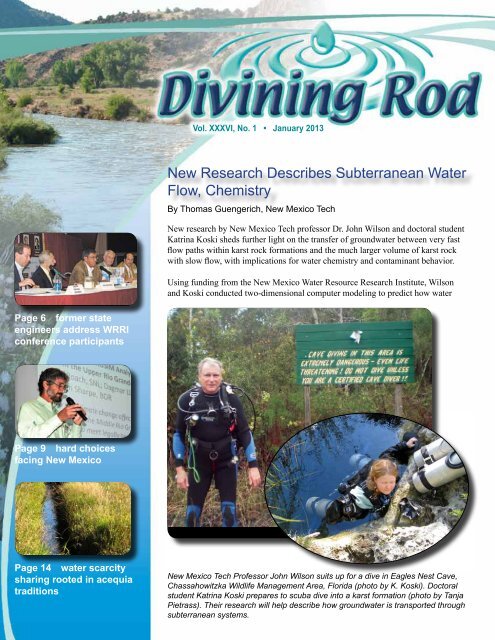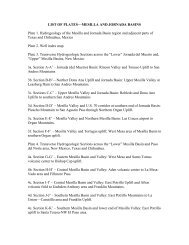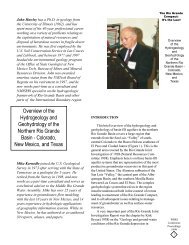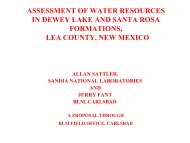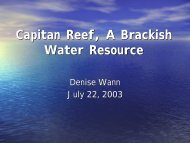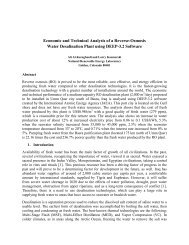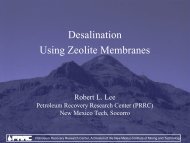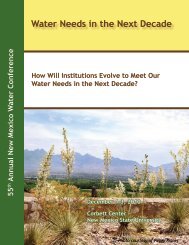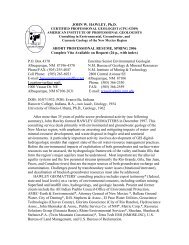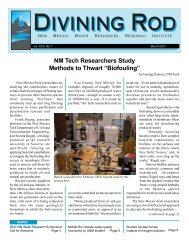NM WRRI - Water Resources Research Institute - New Mexico State ...
NM WRRI - Water Resources Research Institute - New Mexico State ...
NM WRRI - Water Resources Research Institute - New Mexico State ...
Create successful ePaper yourself
Turn your PDF publications into a flip-book with our unique Google optimized e-Paper software.
Vol. XXXVI, No. 1 • January 2013<br />
<strong>New</strong> <strong>Research</strong> Describes Subterranean <strong>Water</strong><br />
Flow, Chemistry<br />
By Thomas Guengerich, <strong>New</strong> <strong>Mexico</strong> Tech<br />
<strong>New</strong> research by <strong>New</strong> <strong>Mexico</strong> Tech professor Dr. John Wilson and doctoral student<br />
Katrina Koski sheds further light on the transfer of groundwater between very fast<br />
flow paths within karst rock formations and the much larger volume of karst rock<br />
with slow flow, with implications for water chemistry and contaminant behavior.<br />
Using funding from the <strong>New</strong> <strong>Mexico</strong> <strong>Water</strong> Resource <strong>Research</strong> <strong>Institute</strong>, Wilson<br />
and Koski conducted two-dimensional computer modeling to predict how water<br />
Page 6 former state<br />
engineers address <strong>WRRI</strong><br />
conference participants<br />
Page 9 hard choices<br />
facing <strong>New</strong> <strong>Mexico</strong><br />
Page 14 water scarcity<br />
sharing rooted in acequia<br />
traditions<br />
<strong>New</strong> <strong>Mexico</strong> Tech Professor John Wilson suits up for a dive in Eagles Nest Cave,<br />
Chassahowitzka Wildlife Management Area, Florida (photo by K. Koski). Doctoral<br />
student Katrina Koski prepares to scuba dive into a karst formation (photo by Tanja<br />
Pietrass). Their research will help describe how groundwater is transported through<br />
subterranean systems.
Published by<br />
The <strong>New</strong> <strong>Mexico</strong> <strong>Water</strong><br />
<strong>Resources</strong> <strong>Research</strong> <strong>Institute</strong><br />
Alexander G. “Sam” Fernald<br />
Director<br />
Catherine T. Ortega Klett<br />
Editor/Coordinator<br />
Will Keener<br />
Writer<br />
Deborah Allen<br />
Project Coordinator<br />
Susanna Heather Glaze<br />
GIS Analyst<br />
Annette McConnell<br />
Admin Assistant Associate<br />
<strong>New</strong> <strong>Mexico</strong> <strong>Water</strong><br />
<strong>Resources</strong> <strong>Research</strong> <strong>Institute</strong><br />
MSC 3167<br />
PO Box 30001<br />
Las Cruces, <strong>NM</strong> 88003-8001<br />
575-646-4337<br />
575-646-6418 (fax)<br />
nmwrri@wrri.nmsu.edu<br />
http://wrri.nmsu.edu<br />
is transported through subterranean<br />
systems and what factors influence the<br />
rate and direction of flow.<br />
This project, titled “Computational<br />
Fluid Dynamics Modeling of Karst<br />
Conduit-Matrix Exchanges with<br />
Relevance in Contaminant Transport,<br />
and Chemical Reactions,” has laid the<br />
groundwork for future field studies,<br />
which recently received funding from<br />
the National Science Foundation (NSF)<br />
and the U.S. Environmental Protection<br />
Agency (EPA).<br />
Karst is a geological term that refers to<br />
underground formations that resemble<br />
Swiss cheese. On a large scale, we<br />
refer to karst features as caves or<br />
caverns. Generally speaking, karst<br />
refers to regions where rock has begun<br />
to dissolve chemically or “undergone<br />
chemical dissolution.” Karst aquifers<br />
are important water sources; they<br />
supply water to 25 percent of the United<br />
<strong>State</strong>s, and some regions rely almost<br />
entirely on such formations; Florida, as<br />
an example, gets 90 percent of its water<br />
from karst. Also, much of the southern<br />
<strong>New</strong> <strong>Mexico</strong> Pecos <strong>Water</strong>shed is karst.<br />
Wilson’s work examines the “hyporheic<br />
zone,” which is the area where water<br />
flows back and forth from the cave – or<br />
conduit – to the karstic rock formations<br />
– or matrix. Hyporheic zones and<br />
hyporheic flow was first characterized<br />
by biologists studying streams where<br />
surface water descends underground<br />
and later reappears in the stream.<br />
Chemists soon started examining<br />
surface hyporheic zones to explain what<br />
happens to dissolved solid organics (and<br />
other chemicals) as they move through<br />
hyporheic zones, as well as looking at<br />
how aquifer water mixes with surface<br />
water. Now, hydrologists like Wilson<br />
and Koski are breaking ground on<br />
subterranean hyporheic zones. In fact,<br />
Wilson was the first hydrologist to<br />
suggest that hyporheic zones could exist<br />
at the margin of a karst conduit.<br />
“If water stays only a short time,<br />
it’s hyporheic flow,” Wilson said.<br />
“Through modeling, we are showing<br />
the propensity for deep flow. One<br />
interesting finding is how the variation<br />
in the karst wall topography impacts<br />
hyporheic flow.”<br />
Scallops – or patterned undulations in<br />
the cave walls – create eddies in the<br />
flow, and hyporheic flows. Many karst<br />
conduits are air-filled with a riverlike<br />
flow at the bottom. This project<br />
specifically examines conduits that are<br />
completely filled with water. In some<br />
cases, given the right pressure, water<br />
can even flow upward through the cave<br />
roof into the matrix.<br />
Karst conduits typically have porous<br />
and permeable walls. Conduits range<br />
in size from building-sized to conduits<br />
too small for a diver. <strong>Water</strong> follows<br />
flowlines from high pressure to low<br />
pressure. For instance, a flooding event<br />
creates high-pressure in the conduit,<br />
forcing flow into the matrix. <strong>Water</strong><br />
tends to flow quickly through the karst<br />
conduit and slowly through the matrix –<br />
or the aquifer. Conduits respond quickly<br />
to precipitation, while aquifers respond<br />
– or recharge – very slowly in response<br />
to rainfall.<br />
In their modeling, Wilson and Koski<br />
accounted for the various characteristics<br />
of the karst conduit and the rock matrix,<br />
varying water pressures, conduit<br />
geometries and flow rates. They also<br />
applied standard physics models that<br />
describe flow rate – like Darcy’s Law<br />
and the Navier Stokes Equations.<br />
2
January 2013<br />
The resulting models show water<br />
flow paths in conduit and matrix, as<br />
well as the travel time through the<br />
hyporheic zone.<br />
As the project’s title suggests,<br />
Wilson’s <strong>NM</strong> <strong>WRRI</strong> research<br />
examines water chemistry and the<br />
transport of contaminants. They<br />
considered how groundwater in the<br />
karst aquifers changes chemically as<br />
it is transported through conduits and<br />
matrix.<br />
Groundwater contains varying levels<br />
of organic and inorganic chemicals<br />
– both natural and anthropogenic.<br />
As water moves through a hyporheic<br />
zone, dissolved chemicals undergo<br />
reduction-oxidation – or redox<br />
reactions. <strong>Water</strong> will enter the matrix<br />
in one chemical state, travel through<br />
the hyporheic zone and return to the<br />
conduit in a different state. Wilson<br />
and Koski’s models show that water<br />
entering the matrix at Point A may<br />
stay sequestered longer than water<br />
entering at Point B. The longer<br />
water is sequestered, the more redox<br />
reactions take place.<br />
“We know the chemical reactions<br />
taking place,” Wilson said. “There’s a<br />
cascade of reactions as the water moves<br />
through the matrix. We are looking at<br />
how water gets sequestered, and how<br />
it is transformed into something less<br />
mobile and less toxic.”<br />
In the absence of sunlight and<br />
biological factors found on the surface,<br />
water becomes anaerobic and then<br />
begins to lose other elements. At some<br />
locations where long-sequestered water<br />
re-enters the conduit, researchers are<br />
even finding mineral deposits.<br />
Wilson and Koski are examining these<br />
chemical changes that occur in the<br />
water.<br />
This simulation depicts a cross-section of flow in a karst conduit and induced<br />
hyporheic flow in the surrounding rock matrix that is located both above and below<br />
the conduit. The ceiling above the conduit has two large cupolas while the floor<br />
is lined with regularly-spaced features called scallops. The upper left (a) depicts<br />
relative flow speed (red = fast, blue = slow) with different color scales in conduit<br />
and matrix. The upper right depicts the distribution of fluid pressure (color, red =<br />
high, blue = low), fluid velocity (arrows), and flow paths in the matrix. The ceiling<br />
morphology drives the hyporheic flow deeper into the matrix ceiling above the<br />
conduit than the smaller scallops drive flow into the matrix below the floor. With<br />
a porous and morphologically complex ceiling and floor, there is an interaction<br />
between the floor and ceiling morphology that creates nested hyporheic flow paths<br />
in the matrix on the other side of the conduit. The relative age of hyporheic flow is<br />
shown in the lower left (color: red = old, blue = new) while in the lower right is the<br />
highly variable spatial pattern of relative residence time for the returning hyporheic<br />
floor to the conduit from the ceiling (top) and floor (bottom). The illustrated domain<br />
is 2m wide and 2.5m tall.<br />
3
Additionally, the researchers also look<br />
at speleogenesis – or cave formation.<br />
They are looking at the chemical<br />
reactions that cause the karst rock,<br />
which can be almost spongy, to<br />
disintegrate over time.<br />
“Rock will basically dissolve from the<br />
inside-out,” Wilson said. “It’s rotting at<br />
depth. We can see the reactions and the<br />
enlargement of karst features.”<br />
The next step in the research of karst<br />
hyporheic flow and water chemistry<br />
will be field studies. Wilson and Koski<br />
are working on a field study in Wakulla,<br />
Florida, near Tallahassee. Using a<br />
$387,000 grant from the NSF, they<br />
will scuba dive into the karst terrain.<br />
(Actually, they will hire NSF-approved<br />
divers because the target location is<br />
both deep and difficult to dive.) They<br />
will take core samples and install<br />
sondes that will measure and transmit<br />
data on water pressure, temperature and<br />
chemistry. The array of instruments will<br />
be the first such observatory dedicated<br />
to the study of hyporheic flow and<br />
chemistry. Koski, who earned her<br />
master’s at <strong>New</strong> <strong>Mexico</strong> Tech in 2000,<br />
will use that field work for her doctoral<br />
dissertation.<br />
“We were selecting an important<br />
scientific question for the dissertation,<br />
one that had not been answered before,”<br />
Wilson said. “Katrina wanted to do her<br />
Ph.D. in flowing caves. I’d been doing<br />
research in air-filled caves and how<br />
gasses exchange. I thought her proposal<br />
was interesting.”<br />
Koski also landed an EPA Star<br />
Fellowship to support her work. The<br />
Fellowship, which includes a stipend<br />
for Koski, allowed Koski’s salary from<br />
the NSF grant to fund another graduate<br />
student, Kenneth Salaz, who originally<br />
earned his bachelor’s at <strong>New</strong> <strong>Mexico</strong><br />
Tech in 1998 and was Tech’s top<br />
undergraduate student that year, earning<br />
him the coveted Brown Medal.<br />
“That’s the really nice thing about this<br />
<strong>NM</strong> <strong>WRRI</strong> grant,” Wilson said. “It has<br />
seeded two new sources of funding that<br />
are continuing today.” S<br />
Acequias and the Future of<br />
Resilience in Global Perspective<br />
Symposium & Workshop<br />
March 2 - 3, 2013<br />
Las Cruces Convention Center<br />
Las Cruces, <strong>NM</strong><br />
Acequias and the Future of Resilience in Global Perspective<br />
This symposium pursues a holistic understanding of acequia irrigation in the upper Rio Grande Valley as made up of interactive,<br />
interdependent biophysical, economic, ecological, and sociocultural systems. It brings together scholars whose perspectives on<br />
comparable social-ecological systems in other parts of the world can shed light on the particular and shared features of <strong>New</strong><br />
Mexican acequias as well as on the challenges they face. Of special interest are questions about whether and how local common<br />
resource pool management can maintain or regain resilience under conditions of accelerating integration into a global economy<br />
and climate change.<br />
4
January 2013<br />
Black carbon impact on water quality focus of USGS 104B research grant<br />
In response to the <strong>NM</strong> <strong>WRRI</strong>’s Request for Proposals in<br />
November 2012 for a seed grant project to be funded through<br />
the U.S. Geological Survey’s 104B program, a water quality<br />
study has been selected. “The transport and accumulation<br />
of pyrogenic black carbon in fire-prone watersheds and<br />
implications for water quality” is under the direction of <strong>New</strong><br />
<strong>Mexico</strong> Tech Assistant Professor of Hydrology Daniel Cadol.<br />
Co-investigators Fred Phillips and Michael Heagy, also from<br />
<strong>NM</strong> Tech, will join the effort.<br />
With a record-setting wildfire season behind us, with the<br />
intensity and frequency of forest fires predicted to increase<br />
as a result of climate change and shifts in land use, and with<br />
its relianance on forested catchments for much of its drinking<br />
water, <strong>New</strong> <strong>Mexico</strong> must make well-informed post-fire<br />
management decisions.<br />
This work will identify the relative importance of mass<br />
movement and river flow in transporting pyrogenic black<br />
carbon through recently burned semi-arid watersheds by<br />
identifying the dominant depositional zones—floodplains,<br />
river banks, or depositional debris fans. The potential for<br />
long-distance transport of debris to downstream reservoirs<br />
represents a threat to drinking water and irrigation supplies<br />
Dan Cadol,<br />
with daughter<br />
Abby,<br />
examining<br />
black carbonrich<br />
deposit<br />
in tributary<br />
of Mineral<br />
Creek, Gila<br />
National<br />
Forest.<br />
that is highly dependent on transport mechanisms. By<br />
determining the likely black carbon transport mechanisms,<br />
this study will assist managers in prioritizing treatment areas<br />
for infrastructure protection.<br />
The mission of the <strong>NM</strong> <strong>WRRI</strong> includes the training of the<br />
state’s future water experts. Principal investigators are<br />
strongly encouraged to include students in their projects. This<br />
one-year, approximately $30,000 project includes financial<br />
support for a graduate research assistant. S<br />
USGS 104G <strong>Water</strong> <strong>Resources</strong> <strong>Research</strong> National Competitive Grants Program RFP<br />
The U.S. Geological Survey in<br />
cooperation with the National <strong>Institute</strong>s<br />
for <strong>Water</strong> <strong>Resources</strong> requests proposals<br />
for matching grants to support<br />
research on the topic of improving and<br />
enhancing the nation’s water supply,<br />
including the following specific areas of<br />
inquiry:<br />
• Evaluation of innovative approaches<br />
to water treatment, infrastructure<br />
design, retrofitting, maintenance,<br />
management and replacement.<br />
• Exploration and model development<br />
of the dynamics of extreme hydrometeorological<br />
events and associated<br />
economic, environmental, social, and<br />
or infrastructure costs.<br />
• Development of methods for<br />
better estimation of water supply,<br />
both surface and groundwater, at<br />
gaged and ungaged sites, including<br />
estimation of the physical supply<br />
and of the economic supply of water.<br />
• Development and evaluation of<br />
alternative approaches and governance<br />
mechanisms for integrated<br />
surface/ground water management.<br />
• Evaluation/assessment of the effects<br />
of water conservation practices, as<br />
well as adoption, penetration and<br />
permanence.<br />
This program provides university<br />
researchers with up to $250,000 for<br />
projects of 1 to 3 years in duration. It<br />
requires a 1:1 non-federal match. The<br />
intent of the program is to encourage<br />
projects with collaboration between<br />
universities and the USGS. Funds have<br />
not been appropriated for this program<br />
but the USGS is proceeding with the<br />
proposal solicitation process in case an<br />
appropriation is received. The RFP at<br />
https://niwr.net/competitive_grants/RFP<br />
gives information on past year funding<br />
including award amounts and funding<br />
success rates.<br />
<strong>Research</strong>ers must submit their proposal<br />
online at the NIWR website. The<br />
deadline is February 21, 2013, by 2pm<br />
MST. If you are interested in submitting<br />
a proposal, please contact <strong>NM</strong> <strong>WRRI</strong><br />
Director Sam Fernald (575-646-4337;<br />
afernald@ad.nmsu.edu as soon as<br />
possible. Proposal and budget should be<br />
reviewed by <strong>NM</strong> <strong>WRRI</strong> no later than<br />
February 14, 2013.<br />
5
<strong>NM</strong> <strong>WRRI</strong> annual water conference presented “Straight Talk”<br />
Needed: Visionary leadership, streamlined policies,<br />
and respect for <strong>New</strong> <strong>Mexico</strong>’s unique traditions<br />
story and<br />
photos by<br />
Will Keener<br />
Eluid Martinez, who served as <strong>New</strong> <strong>Mexico</strong>’s state engineer from 1991 to 1994, calls himself the “last of the water buffaloes.”<br />
As an engineer principally involved in the development of water infrastructure, including dam building, his work has been<br />
criticized in intervening years. “Conservation meant using every drop we could in beneficial uses,” he recalled during a special<br />
panel presentation, called “Straight Talk.” Martinez, who also served as Bureau of Reclamation commissioner from 1995 to<br />
2001, was joined by two other past state engineers, Tom Turney and John D’Antonio as well as a long-time state engineer<br />
assistant, John W. Hernandez, on the panel.<br />
“Then things began to change,” Martinez said, pointing to the public perception of using water for environmental purposes<br />
and concerns about population growth and how to meet its demands. Now, in a water-short era, “People who once criticized<br />
the dam building are saying, if it weren’t for those reservoirs, where would we be?”<br />
Martinez’s story puts the cyclical nature of the state engineer’s job into perspective. Not everything changed, he hastened to<br />
add. The key problem facing the <strong>NM</strong> <strong>WRRI</strong> conference he attended 40 years ago “is the same issue sitting before us today.<br />
How do you meet increasing demand with limited resources?”<br />
“The pressures on the Rio Grande now and other rivers of the state in the future are great,” said Sen. Tom Udall, who<br />
moderated the panel. If we didn’t have the storage in northern <strong>New</strong> <strong>Mexico</strong> reservoirs and the San Juan-Chama project, the<br />
Rio Grande would be dry right now. That’s a pretty shocking thing . . . Where are we going to get the water?”<br />
Straight Talk Panel: Sen. Tom Udall, John Hernandez, Eluid Martinez, Tom Turney, John D’Antonio<br />
6
January 2013<br />
<strong>New</strong> <strong>Mexico</strong> can be considered “the poster child of water users in the U.S.,” John<br />
D’Antonio said. “We’ve got every water user and interest group that any other<br />
state has and more.” D’Antonio served as state engineer from 2003 to 2011. “<strong>New</strong><br />
<strong>Mexico</strong> water issues are “polarizing at times,” he told the audience, “but they<br />
are also rewarding. The water community is here in this room and no matter the<br />
differences and the contentiousness, I still consider it as a family.” Now in times<br />
of extreme drought, “we all know what Scott [Verhines present state engineer]<br />
is going to be facing. We aren’t going to be able to get anywhere unless we<br />
collaborate.”<br />
An obvious choice for bringing water to growing municipalities is to transfer it<br />
from agricultural use. About 75 percent of the state’s water use is for agriculture.<br />
Steve Reynolds, an often-quoted state engineer who served in the post for 35 years<br />
until his death in 1990, estimated that a 10 or 15 percent cut in irrigation water<br />
would allow <strong>New</strong> <strong>Mexico</strong> municipalities to double their population. “The problem<br />
is,” Martinez said, “that right now we are attempting to meet existing demands and<br />
future demands. You cannot accomplish both objectives.”<br />
Eluid Martinez<br />
<strong>New</strong> <strong>Mexico</strong>’s water priority system, the makings of which reach back to the<br />
1500s, calls for all users to be treated equally. Some western states have changed<br />
to a priority system that recognizes the needs of municipalities in times of water<br />
shortages and diverts available waters to them first. “We see these priorities argued<br />
in the courts,” said Tom Turney, state engineer between 1995 and 2003. “Every<br />
user wants the number one priority and the maximum amount of water they can<br />
get.” Changing the priority system would not change that and would be “a terrible<br />
mistake,” he said.<br />
“It’s easy to say we can take water from agriculture to double the state population,<br />
but it’s a mistake to do away with the heritage of agricultural use of water in <strong>New</strong><br />
<strong>Mexico</strong>,” Turney said.<br />
Priority calls may be a thing of the past, said John Hernandez, a 50-year veteran of<br />
the state engineer’s office and professor emeritus at <strong>NM</strong>SU. A 1991 court decision<br />
requiring <strong>New</strong> <strong>Mexico</strong> to find and deliver 18,000 additional acre-feet annually<br />
to Texas resulted in a state acquisition of the water rather than a priority call, he<br />
noted. Asking people with water rights obtained after 1932 to give them up would<br />
have created a difficult and chaotic situation, he said. Then-Governor Bruce King<br />
was easily persuaded to take the acquisition approach.<br />
Tom Turney<br />
“Making a priority call is a good hammer but a hammer that does not work,”<br />
Martinez said.<br />
Also a question with agricultural transfers is “where and how do we take water<br />
out of agriculture?” D’Antonio said. Some two million people live between<br />
Cochiti Pueblo and Las Cruces in the Middle Rio Grande Valley and there is<br />
not enough farmland to provide needed water use permits. “So where do we get<br />
it?” Conservation, reuse of water, and new (non-renewable) supplies through<br />
desalination technologies, may provide part of the solution. Interbasin water<br />
transfers, bringing water from outside the valley, have been proposed twice in<br />
John D’Antonio<br />
7
ecent years, but denied by the state engineer’s office. “This valley is the<br />
economic engine for state. The jobs are going to be there.” Short-term transfers<br />
in drought years, may help provide some flexibility, D’Antonio said.<br />
Once identified, moving water from agriculture to cities and industrial uses<br />
under the current rules and regulations is a difficult process. “The transfer<br />
process is so cumbersome, a city could disappear before you could get through<br />
the process and get a Supreme Court decision,” said Martinez. As a result,<br />
municipal users tend to acquire long-term water rights to avoid the transfer<br />
process.<br />
A short-term transfer process would allow for quick action, “where the<br />
municipalities get the water, but the farmer can continue to farm,” Martinez<br />
said. It has the added advantage of allowing communities to discuss water<br />
needs instead of asking the state to decide, noted Udall. “A village can<br />
talk about their water rights and decide if conservation or infrastructure<br />
improvements are needed, or where the community should head. It should be a<br />
community decision.”<br />
The legislature recognized the slow process involved in transfers and directed<br />
that an expedited process be developed a decade ago, D’Antonio said. The state<br />
engineer established basins, put in place project plans, and set up water masters<br />
to meter use. “We have been at the cutting edge with respect to other states in<br />
the West, trying to put this into place. You can’t manage unless you measure<br />
the water,” he said. The hold-up to the process has come largely as a result of<br />
legal challenges, he said, “not for lack of trying.”<br />
Both Martinez and D’Antonio harkened to the “water buffalo” approach to<br />
water. “The big question is “where’s the next San Juan-Chama project?”<br />
said D’Antonio, who is now deputy district engineer in the Army Corps<br />
of Engineers’ Albuquerque office. “There is no new water. We are fully<br />
appropriated for the most part.” The last large-scale projects had their<br />
beginnings decades ago, he noted. To take pressure off of the state’s<br />
groundwater, <strong>New</strong> <strong>Mexico</strong> should be addressing the building of new water<br />
infrastructure and augmenting supplies. “We’ve got to look for next San Juan-<br />
Chama project. We can’t do it alone, we need to partner with other state and fed<br />
agencies. We need to work together in a lot of different areas,” he said.<br />
In closing, Martinez urged present leaders to value <strong>New</strong> <strong>Mexico</strong>’s unique past,<br />
but not to depend on old ways too much. “Begin to look out of the box based<br />
on new information,” he urged.<br />
“Don’t go immediately to court,” Turney advised. “Keep discussions between<br />
water users alive. Better solutions come from dialog and discussion,” he said.<br />
Use science-based decisions, collaborate with the many experts available to the<br />
state, and seek regional solutions, suggested D’Antonio. “We tend to look too<br />
small sometimes. If we can leverage federal and state programs, we can build<br />
systems that are too large to build on our own,” he said. S<br />
U.S. ranks third in annual<br />
consumption of water<br />
A study conducted by two engineers<br />
at the University of Twente in the<br />
Netherlands calculated how much<br />
water is used around the world and<br />
what countries have the highest<br />
consumption rates. According to<br />
their research, more than 9 billion<br />
cubic meters of water are used<br />
around the world each year. The<br />
countries with the greatest annual<br />
consumption of water are:<br />
China, 1,207 billion cubic meters<br />
India, 1,182 billion cubic meters<br />
U.S., 1,053 billion cubic meters<br />
After the U.S., the amount of water<br />
consumed per country drops of<br />
significantly,” says Klaus Reichardt,<br />
CEO and founder of <strong>Water</strong>less Co.<br />
“For instance, Brazil, which is next<br />
on the list, uses less than half of what<br />
is consumed in the U.S.”<br />
However, the study shows the<br />
amount of water consumed on a per<br />
capita basis can vary significantly.<br />
Even though it is number three on<br />
the top ten list, the U.S. has the<br />
highest per capita water footprint at<br />
2,842 cubic meters per person.<br />
Top ten water consuming countries<br />
in the world are:<br />
1. China<br />
2. India<br />
3. U.S.<br />
4. Brazil<br />
5. Russia<br />
6. Indonesia<br />
7. Pakistan<br />
8. <strong>Mexico</strong><br />
9. Japan<br />
10. Nigeria<br />
8
January 2013<br />
The long view<br />
Bridging the gap between future projected water<br />
demand and supply in the Middle Rio Grande<br />
conference<br />
stories and<br />
photos by<br />
Will Keener<br />
and middle Rio Grande valleys on stream flows, reservoir<br />
levels, and meeting downstream treaty obligations. The<br />
team used several climate variables and 112 computer<br />
runs with 16 different general circulation models to<br />
arrive at a conclusion.<br />
The average model run suggests that on the basis of<br />
climate change alone—without increases to population,<br />
added water conservation, or any changes to current<br />
water operations factored in—<strong>New</strong> <strong>Mexico</strong> could end up<br />
running two million acre-feet short of its obligations to<br />
the Rio Grande Compact by 2100. “That will never fly, of<br />
course, so something has to be done,” Passell said.<br />
Howard Passell, Sandia National Laboratories<br />
<strong>New</strong> <strong>Mexico</strong> is likely to face a significant gap between<br />
supplies of water, energy, and food by the next century.<br />
That’s the conclusion of Howard Passell, a Sandia National<br />
Laboratory scientist, and a group of colleagues, working to<br />
assess the impacts of climate change and population in the<br />
years ahead.<br />
Careful not to call the conclusions “predictions,” Passell<br />
said the modeling results do offer a point of departure for<br />
discussions of the future. Speaking on a panel at the 57 th<br />
Annual <strong>New</strong> <strong>Mexico</strong> <strong>Water</strong> Conference titled “Building a<br />
Plan,” Passell told the audience that state residents will face<br />
hard choices including severe measures “not yet on the table”<br />
should the model scenarios become reality.<br />
An examination of technologies now being investigated<br />
to bridge the supply-demand gap shows that most are<br />
“incremental,” Passell said. But increasing capacity with sure,<br />
but small steps, won’t be enough. “We’re not on track to get<br />
us where we need to be,” he said. “We need transformational<br />
solutions.” Most current solutions simply shift the gap, but do<br />
not eliminate it.<br />
In one case study, researchers from Sandia and the Bureau of<br />
Reclamation looked at climate change impacts in the upper<br />
One possible solution would be to cut agriculture by 50<br />
percent in the middle Rio Grande Valley, to about 25,000<br />
acres. Using the models to evaluate this approach reveals<br />
that such a measure will make up the deficit. “We can fix<br />
the compact problem, but it creates another problem,”<br />
Passell said. “That is, we lose a lot of agriculture.”<br />
Another possible solution is to use water dedicated for<br />
the bosque, or wetlands along the river. By cutting the<br />
bosque in the Middle Rio Grande from 60,000 acres<br />
to 20,000 acres, the compact demands can be met,<br />
according to the computer models. “We no longer have<br />
a gap in terms of the compact, but we’ve created another<br />
gap because we’ve lost the bosque,” Passell said.<br />
Another possibility looked at was lining about 80 percent<br />
of the Rio Grande between Cochiti Reservoir and<br />
Elephant Butte Reservoir by 2100. “That will solve the<br />
deficit, but we are just moving the gap because by lining<br />
the river with concrete we don’t have leakage from the<br />
river to the shallow or deep aquifer, we lose the bosque,<br />
or part of it, and reduce aquifer recharge, and so on,”<br />
Passell said.<br />
Preliminary conclusions of the case study show that these<br />
measures, reducing agriculture or wetlands, or lining the<br />
river channel can solve the compact deficit problem. “But<br />
they lead to many other kinds of gaps and we end up with<br />
many shortages and problems,” he said.<br />
9
Another scenario examined by others at Sandia as part of<br />
other projects was changing cropping patterns and irrigation<br />
methods instead of eliminating agriculture. If drip irrigation<br />
and production of vegetables replace flood irrigation and<br />
alfalfa and grass cultivation, almost as much water could be<br />
saved as by eliminating agriculture all together—although<br />
Passell points out that this just shifts the gap again to those<br />
who grow and use alfalfa and grass hay. “There is a virtue<br />
in maintaining agriculture in the basin because it addresses<br />
food security issues. Right now we import a lot of food from<br />
thousands of miles away. Instead of that we might cultivate<br />
our food in our own basin,” he said.<br />
“Demand reduction in the end may be the only sensible<br />
solution that doesn’t shift the gap,” Passell said. To<br />
accomplish that, population growth control and dramatic<br />
changes in <strong>New</strong> <strong>Mexico</strong>’s water, energy, and food<br />
consumption would be in order, he said. Examples include<br />
more judicious agriculture, smaller and much more efficient<br />
homes and buildings and turning the thermostats down in<br />
winter and up in summer, changes in diet like less dairy and<br />
beef, fewer electronic gadgets and appliances. “Generally<br />
these topics have not been put on the table as possible<br />
solutions,” Passell said. “Too often these kinds of solutions<br />
are marginalized in favor of efforts to simply meet the ever<br />
increasing projected demand.”<br />
“If we can’t meet demand, we are going to have to do other<br />
things. If we can reduce population growth, then we can<br />
move toward a steady state economy—one that doesn’t<br />
depend on constant growth.<br />
Some of these things are pie in the sky and some might even<br />
say that these things are preposterous, but I would suggest<br />
that eliminating our natural capital, impairing the ecosystem<br />
services that have allowed us all to be here is equally<br />
preposterous,” he said. “We need to be looking outside the<br />
box for new sets of solutions. If we don’t have enough water<br />
to meet projected demand, maybe one of the things we have<br />
to do is reduce that demand in the future.” S<br />
Model results show river deliveries going down over time as<br />
a result of climate change alone, not including consumption<br />
from increasing population, and not including efforts at<br />
conservation or demand reduction. The authors of the<br />
study indicate that “Results are not predictions, but rather<br />
a starting point for dialogue and increased awareness of<br />
potential impacts of climate change.”<br />
10
January 2013<br />
Environmental perspective<br />
Time to invest in demand management<br />
instead of large-scale water projects<br />
Two water projects under development<br />
in <strong>New</strong> <strong>Mexico</strong> came in for criticism<br />
by Denise Fort, professor of law at<br />
University of <strong>New</strong> <strong>Mexico</strong> and director<br />
of the Utton Transboundary <strong>Resources</strong><br />
Center in Albuquerque. Fort is taking<br />
the side of the river and the fish in a<br />
state that has “no legal framework for<br />
protecting the ecological aspects of<br />
rivers and streams and has failed to<br />
protect the natural values in our rivers,”<br />
she said.<br />
“Right now in <strong>New</strong> <strong>Mexico</strong>, the fish<br />
lie between agricultural and municipal<br />
interests,” Fort told the 57 th Annual<br />
<strong>New</strong> <strong>Mexico</strong> <strong>Water</strong> Conference.<br />
“<strong>Water</strong> flows to cities and there is not<br />
always necessarily a benefit in that.”<br />
Environmentalists in the state are<br />
working “to make sure not just cities<br />
and rural people but our natural systems<br />
as well are protected,” she said.<br />
“Looking to the future, <strong>New</strong> <strong>Mexico</strong><br />
should manage water demands rather<br />
than investing in large scale water<br />
projects, Fort said. “These projects<br />
have high environmental costs, such<br />
as energy costs to pump the water to<br />
different places other than the river,<br />
from which water is taken.” She<br />
excluded most tribal projects, where<br />
issues are different.<br />
Fort said that although the Arizona<br />
<strong>Water</strong> Settlements Act of 2004 “gave us<br />
the opportunity to get additional water<br />
for <strong>New</strong> <strong>Mexico</strong>,” the additional supply<br />
comes at a high cost. She said the state<br />
“doesn’t necessarily have a need for<br />
the water.” Part of the project would<br />
be paid for with federal funds, but not<br />
all. “I would ask why would the federal<br />
government make a commitment to<br />
provide ‘new water’ for <strong>New</strong> <strong>Mexico</strong>,<br />
rather than looking for cheaper<br />
solutions, which might be available<br />
closer at hand?”<br />
Local communities are looking at<br />
lining leaking water systems and other<br />
measures, she said, but the lure of<br />
$66 million in “free federal money”<br />
is strong. “Once we remove the water<br />
from the river, we have pipeline, energy,<br />
and other projected costs to move the<br />
water to a place where it can be used,”<br />
she said.<br />
She also criticized the Ute Lake<br />
project where Congress has committed<br />
$400 million for a pipeline to deliver<br />
water to eastern <strong>New</strong> <strong>Mexico</strong>. “Were<br />
there cheaper alternatives, including<br />
demand management to address those<br />
needs?” she asked. Unless the federal<br />
government can pay for the bulk of the<br />
project, demand management seems a<br />
better alternative, she said.<br />
Among the hard choices the state must<br />
begin to wrestle with are programs<br />
to reuse water and actions to help<br />
determine what crops are appropriate<br />
to an arid state, she said. “From an<br />
environmental perspective, reuse is a<br />
direction the state should be going when<br />
it makes economic sense.” In the cases<br />
where reuse projects are underway, the<br />
environmental standards have been<br />
quite high and “should be reassuring to<br />
citizens,” she said.<br />
In Australia, when a major river<br />
system was severely degraded, officials<br />
Denise Fort, Utton Transboundary<br />
<strong>Resources</strong> <strong>Institute</strong><br />
invested in buying back water rights<br />
and dedicated water to the environment,<br />
she said. In light of state population<br />
growth and expected climate change<br />
impacts, <strong>New</strong> <strong>Mexico</strong> “should look to<br />
Australia about what hard questions to<br />
ask about what we would like the next<br />
century to be like,” she said. “Let’s<br />
shape the future ourselves.”<br />
Coupled to the Australian approach is<br />
the question of what crops and what<br />
lands are appropriate for agriculture,<br />
she said. In Australia, some crops were<br />
moved to more productive locations to<br />
make agriculture more efficient.<br />
Responding to an audience comment<br />
about the Rio Grande being dry at some<br />
locations, Fort said, “It has to be our<br />
aspiration to actually have a living Rio<br />
Grande up and down the river. . . . <strong>State</strong><br />
law does not provide protection for the<br />
ecological health of the river. The time<br />
has come to change the law and more<br />
explicitly recognize these other values<br />
or we will move to a commoditized<br />
version of water management.” S<br />
11
Refining the answer to ‘how much?’<br />
Climate change, infrastructure, hydrogeology studies<br />
help determine how much water <strong>New</strong> <strong>Mexico</strong> has<br />
How much water does <strong>New</strong> <strong>Mexico</strong><br />
have? The answer depends on a variety<br />
of factors that remain little understood,<br />
high variable, and in need of better<br />
definition. At least that was the answer<br />
of a panel of experts at the 57 th Annual<br />
<strong>NM</strong> <strong>WRRI</strong> Conference held Aug. 28 in<br />
Las Cruces. Although there are general<br />
answers to the question, research is<br />
needed to refine the numbers, they say.<br />
Sam Fernald, director of <strong>NM</strong> <strong>WRRI</strong><br />
and an <strong>NM</strong>SU faculty member, said<br />
understanding how much water is<br />
available to the state<br />
depends on “bringing<br />
a number of different<br />
perspectives”<br />
together to deal with<br />
water management<br />
issues. “We need<br />
more research,”<br />
Fernald said,<br />
adding that a better<br />
understanding of the<br />
quality and extent<br />
of groundwater,<br />
groundwater-surface<br />
water interactions,<br />
and the kinds of<br />
supply variability<br />
that the state will<br />
be facing in coming<br />
years are all needed<br />
to better piece the<br />
puzzle together.<br />
Current figures suggest <strong>New</strong> <strong>Mexico</strong>’s<br />
average yearly “water budget” is about<br />
1.2 million acre-feet of usable water,<br />
Fernald said.Yet there are two million<br />
acre-feet of surface water withdrawals<br />
and four million acre-feet of total<br />
withdrawals in the whole state. Part of<br />
the reason this is possible is that water<br />
for agriculture is reused as it flows<br />
downstream, he said. The balance of<br />
the withdrawals are made by tapping<br />
groundwater. Fernald referred to the<br />
state’s groundwater as “our trust fund.<br />
We are not saving it for a rainy day.”<br />
Dagmar Llewellyn, hydrologist with<br />
the Bureau of Reclamation, said an<br />
assessment of climate change must also<br />
be factored into water estimates. She<br />
said most water users agree that usable<br />
and manageable water “is going to be or<br />
already is in decline.” At the same time,<br />
demand is increasing, causing a gap<br />
between supply and demand. “We try<br />
to avoid talking about climate change,<br />
but it’s incumbent upon us to tackle the<br />
problems of future supply,” she said.<br />
Llewellyn said a study of climate<br />
change impacts on the Rio Grande<br />
is beginning this fall and the Bureau<br />
of Reclamation will be looking for<br />
partners to participate. Chaining of<br />
events connected with climate change<br />
creates highly variable water scenarios<br />
for <strong>New</strong> <strong>Mexico</strong>, Llewellyn said.<br />
“We have to embrace the uncertainty<br />
and concentrate<br />
on adaptive<br />
management.”<br />
Although climate<br />
models do not<br />
necessarily predict<br />
less precipitation<br />
for <strong>New</strong> <strong>Mexico</strong>,<br />
where and when<br />
that water will<br />
be available may<br />
change with new<br />
conditions, she said.<br />
Heat and drought in<br />
the past two years<br />
have already pushed<br />
the state outside its<br />
normal envelope<br />
in temperature<br />
measurements.<br />
Another factor to be considered is the<br />
ability of the state’s water infrastructure<br />
to work in an effective way to preserve<br />
water and deliver it where it is needed.<br />
“A substantial portion of the <strong>New</strong><br />
<strong>Mexico</strong> infrastructure is more than 60<br />
12
January 2013<br />
Mike Darr Dagmar Llewellyn Del Archuleta Sam Fernald<br />
years old,” said Del Archuleta, CEO<br />
of Molzen Corbin and Associates,<br />
an Albuquerque-based planning,<br />
engineering, and architectural firm.<br />
A group of 50 engineers studying the<br />
systems statewide gave it a grade of “C<br />
minus,” he said. The system scored a<br />
“C” (average) for reliability on a daily<br />
basis, but earned a “D” (poor) in the<br />
areas of operation and maintenance,<br />
Archuleta said. “Preventive<br />
maintenance is the last thing we fund in<br />
most places,” he said, noting that much<br />
of the state’s infrastructure is in “poor<br />
condition and not going to get better.”<br />
He called for better accounting of<br />
existing systems, with leak surveys and<br />
other measures and better planning for<br />
improvements.<br />
“If we valued water, we would do<br />
things very differently,” Archuleta said.<br />
<strong>New</strong> <strong>Mexico</strong> is a state with low capital<br />
outlays and low water rates, he said.<br />
“We have to face up as a state, every<br />
one of us, to the true costs of water and<br />
allow our elected officials to build and<br />
run sustainable programs.”<br />
Mike Darr, a hydrologist with the U.S.<br />
Geological Survey in Albuquerque<br />
reviewed his work to better understand<br />
groundwater in the major basins that<br />
cross the border between the U.S.<br />
and <strong>Mexico</strong>. Working with the water<br />
resources and research institutes in<br />
Texas, <strong>New</strong> <strong>Mexico</strong> and Arizona,<br />
the Survey has been hampered by<br />
funding cutbacks, but is<br />
continuing to get results,<br />
he said. Much of the<br />
effort to date has focused<br />
on the Mesilla Basin, in<br />
southern <strong>New</strong> <strong>Mexico</strong>,<br />
and the corresponding<br />
Conejos Medanos Basin<br />
in <strong>Mexico</strong>. Las Cruces, El<br />
Paso, and Juarez all draw<br />
drinking water from this<br />
aquifer.<br />
Officials in <strong>Mexico</strong><br />
are sharing pumping<br />
data with their U.S.<br />
counterparts to help get<br />
a better picture of basin<br />
supplies, Darr said.<br />
“We want to get at the<br />
groundwater quantity and<br />
how to share it fairly,”<br />
he said. Also under<br />
way is a project to use<br />
surface and groundwater<br />
monitoring data to model<br />
the interaction and<br />
relationships between the two water<br />
sources. Darr praised the work of the<br />
late Bobby Creel, associate director of<br />
<strong>NM</strong> <strong>WRRI</strong>, “opening the door for data<br />
exchanges with <strong>Mexico</strong>.” S<br />
13
Acequia view<br />
<strong>Water</strong>-sharing traditions adaptable to 21 st Century<br />
For smaller agriculture users in <strong>New</strong> <strong>Mexico</strong>, answers<br />
to the water shortage are found in the wisdom of the<br />
early Native Americans and Spanish settlers, as well as<br />
in the language of prior appropriation. “<strong>Water</strong> scarcity is<br />
nothing new in <strong>New</strong> <strong>Mexico</strong>,” said Paula Garcia, director<br />
of the <strong>New</strong> <strong>Mexico</strong> Acequia Association. “Scarcity is<br />
deeply rooted in the land and the people.”<br />
Early state societies have long memories, preserved in<br />
oral histories, of dealing with water scarcity “based on a<br />
sense of mutuality,” she said. “We have a lot to learn from<br />
that type of knowledge as a framework for water sharing.”<br />
Garcia’s remarks came during a panel discussion at the<br />
57 th Annual <strong>New</strong> <strong>Mexico</strong> <strong>Water</strong> Conference on August 28,<br />
2012. Garcia, who is also a Mora County commissioner,<br />
urged state and federal water managers to work with local<br />
majordomos and other community leaders to establish a<br />
relationship of negotiation and collaboration within the<br />
prior appropriation framework.<br />
Prior appropriation is a legal framework used in most<br />
Western states to settle water disputes. The system awards<br />
water rights based on the dates of filing, with “senior”<br />
or early water users having the priority over “junior”<br />
rights holders. The acequia systems hold relatively senior<br />
water rights, which is a blessing, Garcia said. Farmers<br />
understand that “the bigger numbers are going to prevail”<br />
and that communities must have water. “We all have a<br />
stake in having a viable agriculture system, where we can<br />
produce our food locally and it doesn’t always have to<br />
come to conflict,” Garcia said.<br />
<strong>New</strong> <strong>Mexico</strong> acequia (photo by Will Keener)<br />
“From a custom of sharing water between acequias, we<br />
are starting to see discussions of sharing water across<br />
entire basins, or cities and towns sharing with irrigators.<br />
Prior appropriation is a factor, but now we are seeing<br />
parties willingly coming together to share water,” she told<br />
the audience.<br />
12 14
January 2013<br />
<strong>Water</strong> markets are in place in <strong>New</strong> <strong>Mexico</strong> for buying<br />
and selling of water rights and they are “increasingly<br />
viewed as a remedy for supply problems.” The problem<br />
with these markets, she said, is that they focus only on the<br />
economic value of water and are not “mindful of impacts<br />
on rural communities. . . . Unfettered, water markets<br />
could end our agricultural future.”<br />
A system that “allows for changing needs, but also<br />
protects what we find valuable for our communities,” is<br />
needed, she said. “We need an adaptive regulatory format<br />
for water transfers rather than permanent transfers. We<br />
need to allow water to stay in agriculture over the longterm,<br />
but still use it to address short-term shortages,”<br />
Garcia said. The state engineer has proposed alternative<br />
water administration tools for the state to administer by<br />
priority, with the flexibility to say that if the parties can<br />
come together and work out an agreement that will be a<br />
viable approach, she said.<br />
She called for users’ incentives to negotiate rather than<br />
fall back on the appropriations system, when considering<br />
new projects. Planning can ensure that access to water is<br />
equitable for all users, she said. “This is not a zero sum<br />
game, where agriculture loses and some other user with<br />
more resources tends to use the water.”<br />
Paula Garcia, <strong>New</strong> <strong>Mexico</strong> Acequia Association<br />
Despite daunting challenges, <strong>New</strong> <strong>Mexico</strong> can improve<br />
and adapt to changing conditions, she said. “We have<br />
a spirit of cooperation and a broader view of not only<br />
looking at our own rights and defending the rights for<br />
our communities, but also looking at the water and<br />
taking care of it for future generations.” S<br />
James Witcher inducted to Geology Hall of Fame<br />
Congratulations to James Witcher who was added to the Geology Hall<br />
of Fame this year to honor his contributions in the field of geothermal<br />
energy. A celebration of Witcher’s career was held on Friday, October<br />
26, 2012 at the Geology Hall of Fame Luncheon, at the Farm and Ranch<br />
Heritage Museum in Las Cruces.<br />
Jim owns Witcher and Associates of Las Cruces, a geothermal consulting<br />
company, and was honored as the preeminent researcher on geothermal<br />
energy in <strong>New</strong> <strong>Mexico</strong> in 2009 by the <strong>New</strong> <strong>Mexico</strong> Energy, Minerals and<br />
Natural <strong>Resources</strong> Department, and the <strong>New</strong> <strong>Mexico</strong> Bureau of Geology<br />
and Mineral <strong>Resources</strong>.<br />
Dr. Nancy McMillan, <strong>NM</strong>SU Geosciences<br />
Department Head, presents James Witcher<br />
with a certificate commemorating his induction<br />
into the Geology Hall of Fame.<br />
Having graduated with a BS in 1977 and an MS in 1993 from <strong>NM</strong>SU,<br />
Jim has had a long association with the <strong>NM</strong> <strong>WRRI</strong>. He is the first author<br />
of a 2004 <strong>NM</strong> <strong>WRRI</strong> technical report entitled, “Sources of Salinity in<br />
the Rio Grande and Mesilla Basin Groundwater” and presented a talk<br />
at <strong>NM</strong> <strong>WRRI</strong>’s 2011 annual water conference, “Geothermal <strong>Resources</strong><br />
Suitability for Desalination in <strong>New</strong> <strong>Mexico</strong>.”<br />
15
A <strong>New</strong> <strong>Mexico</strong> Centennial History Series Book<br />
Edited by Catherine T. Ortega Klett<br />
<strong>New</strong> <strong>Mexico</strong> <strong>Water</strong> <strong>Resources</strong> <strong>Research</strong> <strong>Institute</strong><br />
Published by Sunstone Press<br />
ISBN 978-0-86534-902-5<br />
290 pages, softcover<br />
Place your orders<br />
Order books by emailing <strong>NM</strong> <strong>WRRI</strong> at<br />
nmwrri@nmsu.edu<br />
Make checks payable to <strong>NM</strong> <strong>WRRI</strong> and mail to:<br />
<strong>NM</strong> <strong>WRRI</strong>, MSC 3167<br />
<strong>New</strong> <strong>Mexico</strong> <strong>State</strong> University<br />
PO Box 30001<br />
Las Cruces, <strong>NM</strong> 88003-8001<br />
Or call 575-646-4337 with your credit card number<br />
Books ordered through <strong>NM</strong> <strong>WRRI</strong> are<br />
$30, includes tax and shipping<br />
One Hundred<br />
Years of<br />
<strong>Water</strong> Wars<br />
in <strong>New</strong> <strong>Mexico</strong><br />
1912-2012<br />
The book contains 16 chapters<br />
on the many complex and messy<br />
fights, legal and otherwise, over<br />
precious water in a semiarid<br />
western state. Focusing on<br />
the past one hundred years<br />
constituting <strong>New</strong> <strong>Mexico</strong>’s<br />
statehood, contributors describe<br />
the often convoluted and always<br />
intriguing stories that have shaped<br />
<strong>New</strong> <strong>Mexico</strong>’s water past and that<br />
will, without doubt, influence its<br />
future history.<br />
chapters by<br />
James Brockmann<br />
Calvin Chavez<br />
Michael Connor<br />
Charles DuMars<br />
Em Hall<br />
Linda Harris<br />
John Hernandez<br />
Eluid Martinez<br />
Kay Matthews<br />
John Nichols<br />
Sylvia Rodríguez<br />
Richard Simms<br />
Jay Stein<br />
John Utton<br />
Jerald Valentine<br />
Karl Wood<br />
USGS <strong>New</strong>s<br />
Stratigraphy and Depositional<br />
Environments of the Upper<br />
Pleistocene Chemehuevi Formation<br />
Along the Lower Colorado<br />
River by D.V. Malmon,<br />
K.A. Howard, P.K. House, S.C.<br />
Lundstrom, P.A. Pearthree,<br />
A.M. Sarna-Wojcicki, E. Wan,<br />
and D.B. Wahl, Professional<br />
Paper 1786. http://pubs.er.usgs.<br />
gov/publication/pp1786<br />
USGS and Google Partner on<br />
Emergency Alerts: Emergency<br />
notifications for earthquakes,<br />
severe weather and other<br />
public safety matters are now<br />
available through Google<br />
Public Alerts. http://www.<br />
usgs.gov/newsroom/article.<br />
asp?ID=3446<br />
<strong>New</strong> Evidence Shows Power of<br />
East Coast Earthquakes: Earthquake<br />
shaking in the eastern<br />
United <strong>State</strong> can travel much<br />
farther and cause damage over<br />
larger areas than previously<br />
thought. http://www.usgs.gov/<br />
newsroom/article.asp?ID=3447<br />
Confidence in Climate Date:<br />
Using 3 Million-Year-Old<br />
Records: Scientists look at<br />
climate conditions 3 million<br />
years ago, during the Pliocene,<br />
and are confident in the accuracy<br />
of their data. http://www.<br />
usgs.gov/newsroom/article.<br />
asp?ID=3147<br />
16


